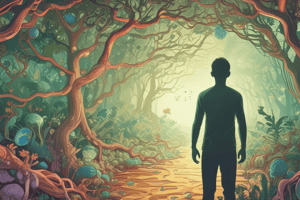Podcast
Questions and Answers
What is the typical size range of microorganisms?
What is the typical size range of microorganisms?
- micrometers (μm) or nanometers (nm) (correct)
- kilometers (km)
- millimeters (mm)
- centimeters (cm)
Viruses are considered living cells.
Viruses are considered living cells.
False (B)
Microorganisms can be found almost everywhere on Earth, including in ___________________, water, air, and living organisms.
Microorganisms can be found almost everywhere on Earth, including in ___________________, water, air, and living organisms.
soil
Match the following types of microorganisms with their characteristics:
Match the following types of microorganisms with their characteristics:
What is the role of microorganisms in decomposition?
What is the role of microorganisms in decomposition?
What is the process by which microorganisms convert elements into forms usable by other organisms?
What is the process by which microorganisms convert elements into forms usable by other organisms?
Microorganisms play a crucial role in the human gut microbiome.
Microorganisms play a crucial role in the human gut microbiome.
What is the term for the highly resistant, dormant forms of bacteria and fungi that can survive extreme conditions?
What is the term for the highly resistant, dormant forms of bacteria and fungi that can survive extreme conditions?
Flashcards are hidden until you start studying
Study Notes
Characteristics of Microorganisms
- Microorganisms are living organisms that are too small to be seen with the naked eye
- They are typically measured in micrometers (μm) or nanometers (nm)
- Microorganisms can be found almost everywhere on Earth, including in soil, water, air, and living organisms
Types of Microorganisms
- Bacteria: prokaryotic cells, typically 1-5 μm in size, with a cell wall and no nucleus
- Examples: E. coli, Staphylococcus aureus, Bacillus subtilis
- Viruses: not considered living cells, consist of genetic material (DNA or RNA) surrounded by a protein coat
- Examples: influenza virus, HIV, COVID-19
- Fungi: eukaryotic cells, can be single-celled or multicellular, with a cell wall and a nucleus
- Examples: yeast, mold, mushrooms
- Protists: eukaryotic cells, can be single-celled or multicellular, with a cell wall and a nucleus
- Examples: protozoa, algae, slime molds
- Archaea: prokaryotic cells, similar to bacteria, but with unique metabolic processes
- Examples: methanogens, thermophiles, halophiles
Microorganism Growth and Reproduction
- Binary fission: a type of asexual reproduction where a cell divides into two identical daughter cells
- Spores: highly resistant, dormant forms of bacteria and fungi that can survive extreme conditions
- Colonies: groups of microorganisms that grow together, often forming visible patterns or structures
Importance of Microorganisms
- Decomposition: microorganisms break down organic matter, recycling nutrients and energy
- Nutrient cycling: microorganisms convert elements such as nitrogen, carbon, and sulfur into forms usable by other organisms
- Food production: microorganisms are used in fermentation processes to produce foods such as bread, cheese, and yogurt
- Human health: microorganisms play a crucial role in the human gut microbiome, influencing digestion and immune function
Characteristics of Microorganisms
- Microorganisms are living organisms too small to be seen with the naked eye, measured in micrometers (μm) or nanometers (nm)
- They can be found almost everywhere on Earth, including in soil, water, air, and living organisms
Types of Microorganisms
- Bacteria: prokaryotic cells, 1-5 μm in size, with a cell wall and no nucleus, examples include E. coli, Staphylococcus aureus, and Bacillus subtilis
- Viruses: not considered living cells, consisting of genetic material (DNA or RNA) surrounded by a protein coat, examples include influenza virus, HIV, and COVID-19
- Fungi: eukaryotic cells, single-celled or multicellular, with a cell wall and a nucleus, examples include yeast, mold, and mushrooms
- Protists: eukaryotic cells, single-celled or multicellular, with a cell wall and a nucleus, examples include protozoa, algae, and slime molds
- Archaea: prokaryotic cells, similar to bacteria, but with unique metabolic processes, examples include methanogens, thermophiles, and halophiles
Microorganism Growth and Reproduction
- Binary fission: a type of asexual reproduction where a cell divides into two identical daughter cells
- Spores: highly resistant, dormant forms of bacteria and fungi that can survive extreme conditions
- Colonies: groups of microorganisms that grow together, often forming visible patterns or structures
Importance of Microorganisms
- Decomposition: microorganisms break down organic matter, recycling nutrients and energy
- Nutrient cycling: microorganisms convert elements such as nitrogen, carbon, and sulfur into forms usable by other organisms
- Food production: microorganisms are used in fermentation processes to produce foods such as bread, cheese, and yogurt
- Human health: microorganisms play a crucial role in the human gut microbiome, influencing digestion and immune function
Studying That Suits You
Use AI to generate personalized quizzes and flashcards to suit your learning preferences.




